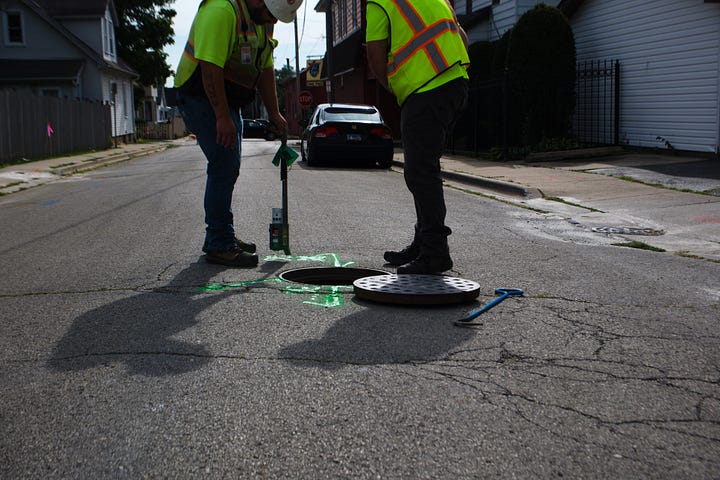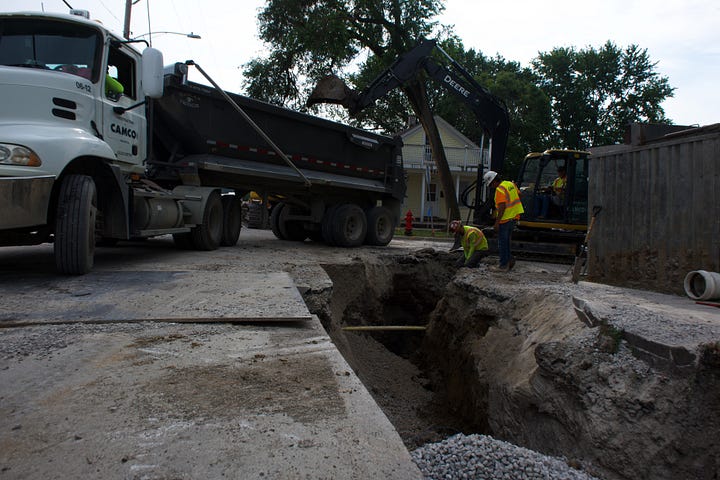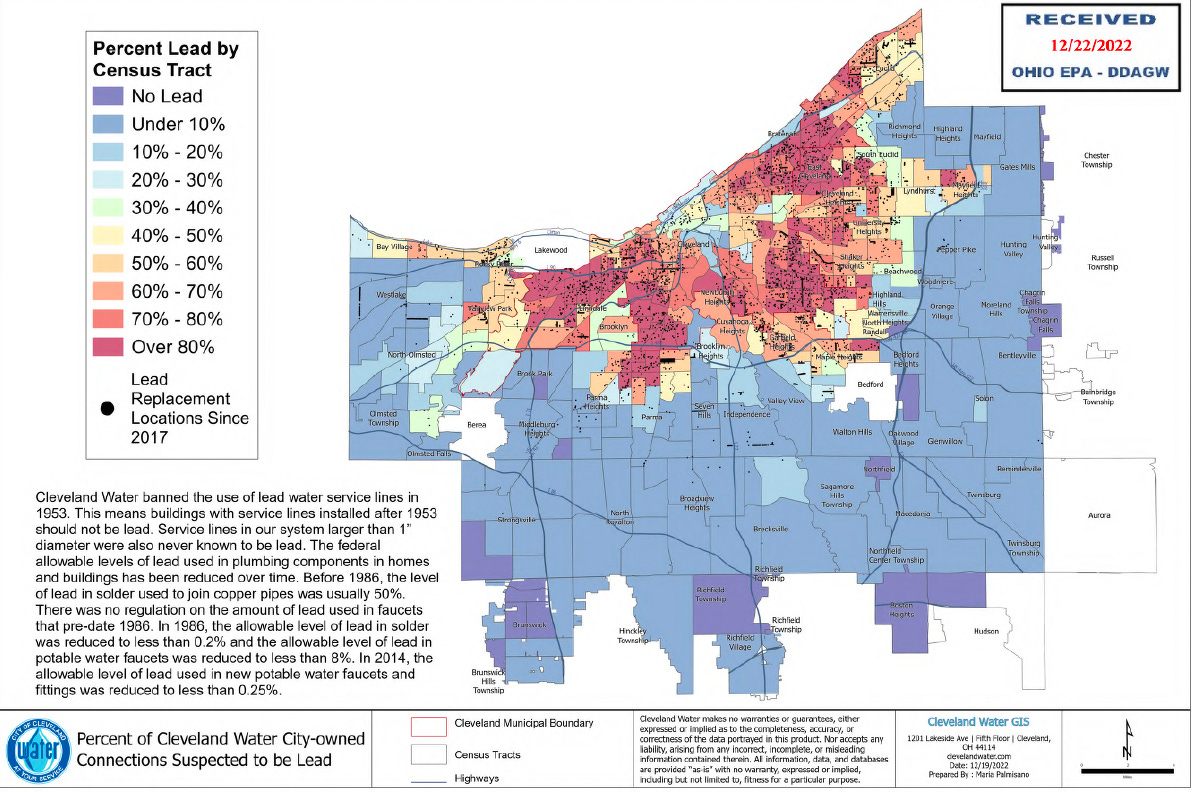Cleveland Water Says Customers Can be Confident The Water Delivered to Their Home is Safe, But Is It Lead-Free?
In a push to remove all lead service lines in the U.S. within 10 years, President Joe Biden says, "There is no safe level of lead exposure. Period. None."
On October 8th, 2024, in Milwaukee, WI, President Joe Biden announced that the Environmental Protection Agency has written into law that every single lead service line within the United States needs to be replaced within 10 years. “There is no safe level of lead exposure. Period. None.” Biden said.
The fact there is no safe level of lead exposure has been expressed by scientists for at least a decade, but regulations on lead within our water infrastructure have lagged behind. “Lead poisoning is a big problem happening today,” said Dr. Ana Navas-Acien, a Professor and the Chair of Environmental Health Sciences at the Columbia Mailman School of Public Health. “We need to do as much as we can to remove lead from the environment.”
According to the Natural Resources Defense Council, Cleveland ranks second behind Chicago as the city with the most lead service lines in the country, with over 235,000 lead service lines providing drinking water to Cleveland residents.
Despite the high concentration of lead service lines, the Ohio Environmental Protection Agency (EPA) and Cleveland Water believe the city's water to be safe. “I want to be clear that Cleveland’s water is safe, even if you have a lead service line,” said Anne Vogel, the director of Ohio EPA.
In a recent mailer sent out to Cleveland Water users, the water utility company claims “Cleveland Water customers can be confident that the water delivered to their home is safe.” The mailer goes on to list the steps Cleveland Water is taking to reduce the harm of lead in its water infrastructure to Cleveland customers.
The reassurances in this mailer, and much of Cleveland Water’s messaging, neglects to acknowledge the science that suggests Cleveland Water users shouldn’t be completely confident that Cleveland Water is delivering safe drinking water to their taps. Cleveland Water declined an interview at the time this article was written.
“When you are looking at safe water, and water systems are saying ‘our water is safe,’ they are usually talking about the sampling that is at the water treatment plant, and they aren’t reporting on any context of what people are actually drinking at their own home,” said Elin Betanzo with Safe Water Engineering at a workshop this past August.
“They aren’t reporting any context of what people are actually drinking at their own home.”
-Elin Betanzo, Safe Water Engineering
The mailer explains that drinking water is lead-free when it leaves the treatment plant, that they optimize water chemistry to minimize corrosion of pipes and plumbing, that they use orthophosphate, a food-grade nutrient, as corrosion control, and that they sample customers' water for lead. Cleveland water claims “the results show that our water is safe.”
While Cleveland Water has taken these steps to reduce the chances of lead contaminating the water coming out of their customers taps, these steps do not ensure that the water their customers receive is lead-free.
Lead-free water leaving the treatment plant
Cleveland Water can accurately state that they have lead-free water when it leaves the treatment plant, but that is not the case for the water that arrives at their customers taps, which is most important. Even with corrosion control, there is a chance that customers with a lead service line have lead in their water.
Orthophosphate and Corrosion Control
Corrosion control is an essential tool for reducing the amount of lead that seeps into existing lead service lines, but it does not guarantee lead-free water coming out at the tap. Many water systems use modeling to predict the solubility of lead with their chosen corrosion control to help determine its effectiveness. A 2019 study showed that there are “considerable discrepancies” between the modeling for corrosion control and the actual lead released into water in the field.
How the EPAs Lead and Copper Rule Hides Elevated Levels of Lead Behind the 90th Percentile
Cleveland Water, like all other public water companies, is required to monitor the levels of lead in their system using the EPAs Lead and Copper Rule. According to the summary data on Drinking Water Watch, Cleveland Water has been in compliance with the Lead and Copper Rule since it was created in 1991. Cleveland Water only has to collect samples to test for lead once every three years, and the sample has to be of at least 50 houses with a lead service line.
When Cleveland Water states that their “results are safe,” they only legally need to disclose if their tests show that the 90th percentile of their samples is above the EPA action level of 15 parts per billion. This rule allows a lot of room for Cleveland Water users to be drinking water with higher levels of lead than the disclosed amount.
Even though Cleveland Water is in compliance with the Lead and Copper Rule, that does not mean the drinking water coming from customers taps is lead-free. For Cleveland Water, or any other water utility to be out of compliance, only the 90th percentile of samples taken from customers taps needs to be above the lead action level of 15 parts per billion.
In October, the EPA lead action level was reduced from 15 parts per billion to 10 parts per billion, but this number is still drastically higher than the action level recommended by the American Academy of Pediatrics, which is 1 parts per billion for any water consumed by children.
As written in a policy statement from the American Academy of Pediatrics, “The action level is used as an administrative tool to evaluate community-level exposure; it is not a health-based standard. The maximum contaminant level goal, the value the EPA deems acceptable for health, is 0.”
According to the sample data on Drinking Water Watch, in 2016, the 90th percentile of the sample data collected was 1.7 parts per billion. While this is a relatively low level of lead, the 90th percentile does not take into account the highest 10 percent of the data set, which can be any number above that disclosed 1.7 parts per billion.
When looking at water sample data from Flint, Michigan before the Flint water crisis, the 90th percentile of their samples put them within compliance of the EPA’s Lead and Copper Rule at somewhere between 11 and 13 parts per billion. What this number didn’t show is the six water samples that were drastically above the EPA action level, sitting at 18, 21. 22, 29, 42, and 42 parts per billion.
Without access to the full data collected from Cleveland Water, there is no way to know how high the highest levels from their sample were, or whether they are considered safe.
Another challenge with lead service lines and testing for lead release at the tap is that there is no rhyme or reason for when lead levels spike. “Lead release in water is sporadic,” said Elin Betanzo with Safe Water Engineering. “You don’t get a consistent level, and that’s one reason why lead is so dangerous. One day it can be zero, the next it can be 900. You can’t predict which day is safe and which day is not,” she said.
The Push to Remove Lead Service Lines
In recent years, the push to remove lead service lines has gained momentum and funding. The Bipartisan Infrastructure Law provided $15 billion for lead service line replacement nationwide, along with another $11.7 billion that can be used for drinking water projects and lead service line replacement. Cleveland Water has received $61 million in financial support from the Bipartisan Infrastructure Law to replace lead service lines.


Cleveland began replacing customer-owned lead service lines when completing water main replacements and repairs in 2018, taking the opportunity to reduce disrupting neighborhoods with construction more than once.
Starting in 2021, Cleveland Water began a program to replace all lead service lines to licensed daycares and completed the process in 2022.
What Can Be Done In the Meantime?
The proposed deadline for Ohio to have all lead service lines removed is 2037. While the City of Cleveland and the Ohio EPA are putting in the hard work to remove all lead service lines within the city, it is important to know how to protect yourself and your family from lead exposure through your drinking water.
In the meantime, report your lead service line material to Cleveland Water to help them with the process of cataloging all service lines that have lead. If Cleveland Water contacts you about replacing your lead service line, comply with their efforts. They are trying to help keep you and your family safe.
Here are some ways you can protect yourself if you have a lead service line:






Great reporting and very eye opening! Thanks for this! Looking forward to more ❤️